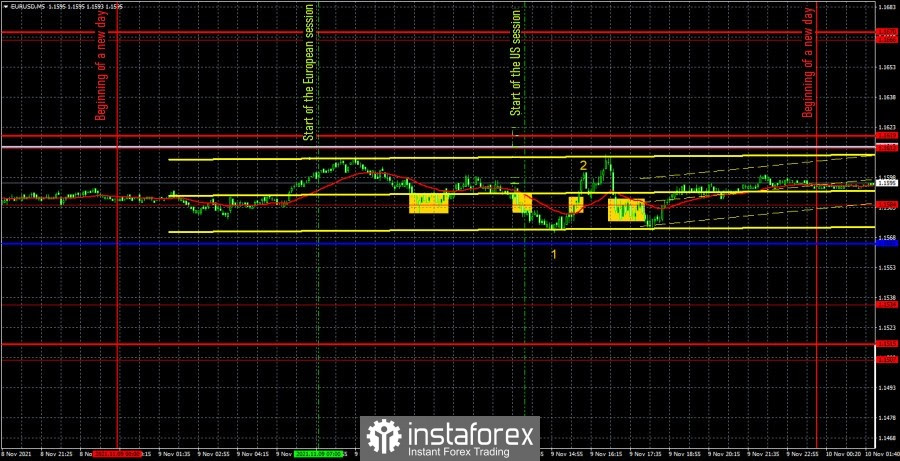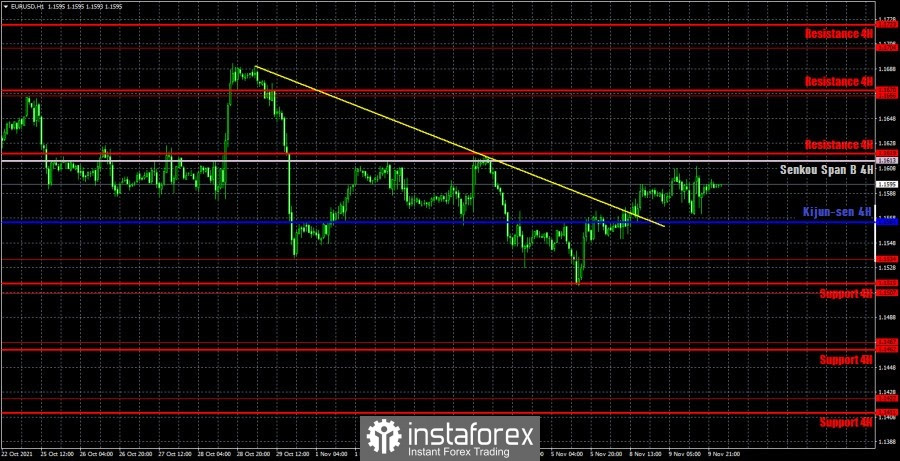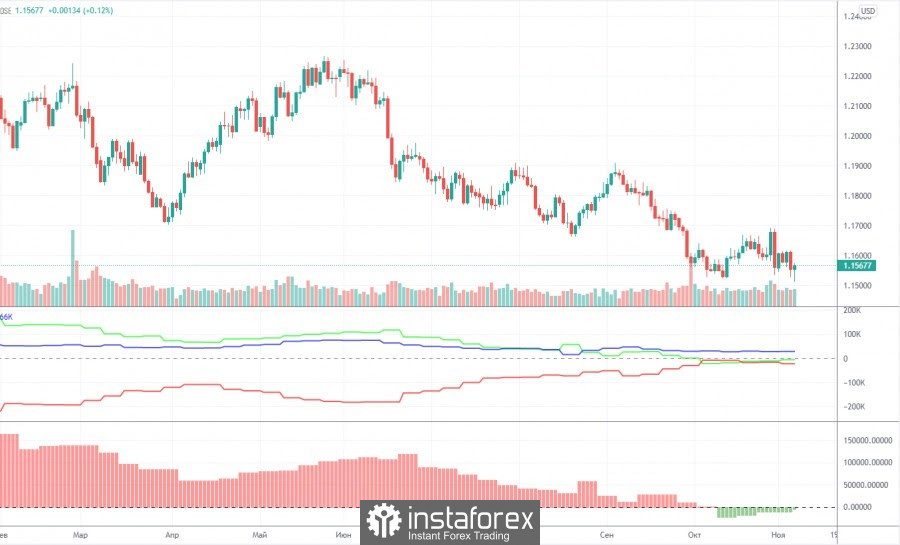EUR/USD 5M

The EUR/USD pair continued to trade very sluggishly during the second trading day of the week. Not that it was obvious. After all, speeches by European Central Bank President Christine Lagarde and Federal Reserve Chairman Jerome Powell were scheduled for yesterday. However, in yesterday's review, we warned that there is a probability of almost 100% that these speeches will not give the markets any new information. Consequently, there will be no reaction to them. And so it turned out to be true. Despite the fact that the euro/dollar pair changed the direction of movement after the beginning of each of these events, the total volatility of the day amounted to 40 points again. The number "1" marks the beginning of Lagarde's speech, the number "2" - Powell's speech. In any case, the price changes after these events were minimal. With trading signals, things are even sadder. No strong trading signals were generated on Tuesday. The price was selected several times to the lines of the Ichimoku indicator, but each time it lacked only a few points in order to work them out. But the price has danced a lot around the extreme level of 1.1584. It was overcome four times in a day, so four signals were generated. Since this level was located neatly between the Senkou Span B and Kijun-sen lines, it is not surprising that all the signals turned out to be false. The price was just flat all day. Let's try to figure out how to trade on Tuesday. One should have attempted to work out the first buy signal. However, after its formation, the price went up 8 points, and then settled below the level of 1.1584. Therefore, it was necessary to close long positions and open short positions. However, short positions did not bring profit either, as the price almost immediately turned up and settled above 1.1584. As a result, a loss of 21 points was received for these two transactions. The next two trading signals should not have been worked out, since at that time two false signals had already formed near the level of 1.1584.
EUR/USD 1H

The downward trend reversed very quickly on the hourly timeframe. As we have already said many times, the movements for the euro/dollar pair are the most confusing at this time. They cannot be called either trendy or flat. Now the price is between the Senkou Span B and Kijun-sen lines, which further confuses the overall technical picture. On Wednesday, we highlight the following levels for trading - 1.1467, 1.1507, 1.1534, 1.1666, as well as the Senkou Span B (1.1613) and Kijun-sen (1.1564) lines. The Ichimoku indicator lines can change their position during the day, which should be taken into account when looking for trading signals. Signals can be rebounds or breakthroughs of these levels and lines. Do not forget about placing a Stop Loss order at breakeven if the price moves 15 points in the right direction. This will protect you against possible losses if the signal turns out to be false. At the 4-hour TF, the Bollinger Band indicator signals a flat, so signals near the Ichimoku indicator lines may be false. Nothing interesting will happen in the European Union on November 10. But a report on inflation for October will be published in the United States , and this report is rightfully considered the most important this week. Of course, it is not a fact that the reaction of the markets will be strong, but it can be so, therefore, this report cannot be missed.
We recommend you to familiarize yourself:
Overview of the EUR/USD pair. November 10. The US dollar is slowly creeping downward. This movement can stretch over months
Overview of the GBP/USD pair. November 10. The UK continues to calculate the losses from leaving the EU
Forecast and trading signals for GBP/USD for November 10. Detailed analysis of the movement of the pair and trade deals.
Analysis of the COT report

The mood of non-commercial traders changed, but not much, during the last reporting week (October 26-November 1). A group of "non-commercial" traders closed 4,000 buy contracts (longs) and 10.5 thousand sell contracts (shorts) during the reporting week. Consequently, the net position of professional players has grown by 6.5 thousand, which is not so much. However, the changes in the mood of non-commercial traders are best seen by the first indicator in the chart above. The red and green lines have been moving towards each other for a long time, and in the last couple of months they have been almost at the same level. This suggests that the previous trend is ending, and the mood of the major players at this time is as neutral as possible. This is confirmed by the data on the total number of contracts. The non-commercial group has 195,000 buy contracts (longs) and 199,000 sell contracts (shorts). The commercial group has 418,000 buy contracts and 442,000 sell contracts. That is, as we can see, the numbers are almost the same. Therefore, there are theoretical chances for the continuation of the downward movement in the pair. The trend began to end (an upward trend) when the red and green lines (net positions of the commercial and non-commercial groups) began to narrow. That is, for quite a long time. And now, logically, the downward trend continues. However, this "trend" is still not too similar to the trend. Rather, a banal three-wave correction.
Explanations for the chart:
Support and Resistance Levels are the levels that serve as targets when buying or selling the pair. You can place Take Profit near these levels.
Kijun-sen and Senkou Span B lines are lines of the Ichimoku indicator transferred to the hourly timeframe from the 4-hour one.
Support and resistance areas are areas from which the price has repeatedly rebounded off.
Yellow lines are trend lines, trend channels and any other technical patterns.
Indicator 1 on the COT charts is the size of the net position of each category of traders.
Indicator 2 on the COT charts is the size of the net position for the non-commercial group.





















